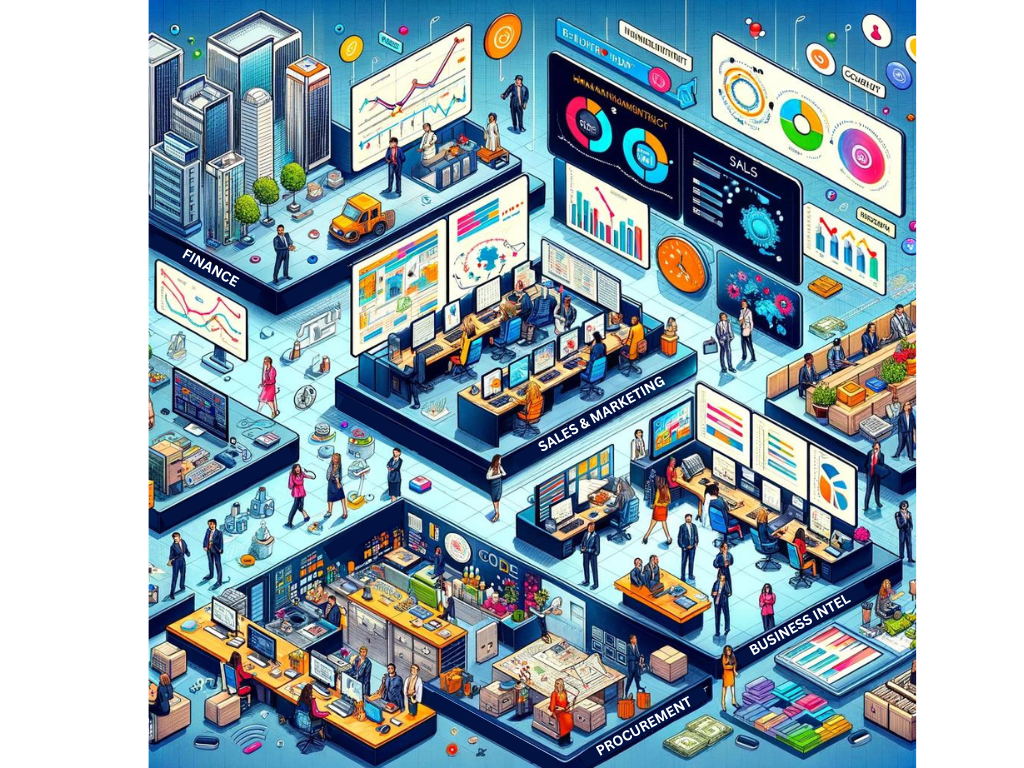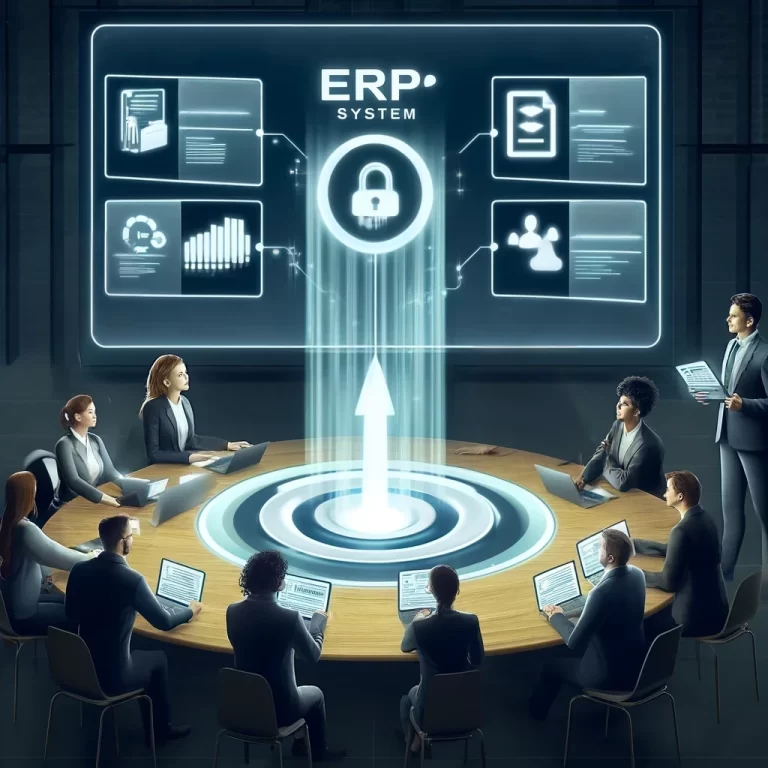Enterprise Resource Planning (ERP) is a software technology that covers or integrates various core business processes, such as finance, HR, manufacturing, supply chain, and more, into a unified system. By improving data collection and access with a more convenient User interface, providing automation opportunities for simple or repeatable tasks, and allowing aggregation of the data across different departments, ERP software creates a digital workspace that enhances efficiency, promotes data integrity, and fosters informed decision-making across an organization. Modern ERP leverage cloud computing, artificial intelligence, and machine learning to offer intelligent automation and insightful analytics, empowering businesses to stay competitive. Beyond just internal operations, these systems facilitate collaboration with global partners by providing them with different ways to integrate into your business, offering speed vital for today’s market. Moreover, ERP systems optimize back-office functions, boost productivity, and offer real-time insights into the business, crucial for organizations aiming to grow in the future (see examples here).
Importance of ERP Systems in Business
ERP software is crucial for businesses because it serves as the enterprise’s operational backbone, facilitating and automating processes across various departments. Such a system ensures that all organizational data is centralized, and that way enhances decision-making accuracy.
For instance, finance teams depend on ERP for rapid financial closing processes, while sales departments use it to handle customer transactions or to trace and follow up all of their sales-oriented actions. Logistics departments count on ERP for timely and accurate delivery of products and services. Similarly, it aids accounts payable in managing supplier payments efficiently and provides management with real-time insights into business performance.
Moreover, reliable, and accurate financial reporting, facilitated by ERP, is essential for banks and shareholders. Reflecting its significance, the ERP software market is on an upward trajectory, with forecasts predicting substantial growth, underscoring the system’s increasing adoption and pivotal role in modern business operations.
Main Business Benefits of ERP Systems
Implementing an Enterprise Resource Planning (ERP) system brings substantial advantages to businesses of all sizes. Here’s a breakdown of the key benefits:


- Centralization of Data: With more people participating in business activities the information might be saved in separate excel documents that are shared inside the organization for different reasons. The information might not be written down at all or held inside the personal notebook of a sales assistant or an employee participating in a logistics chain.
Such data management might lead to a bottleneck, missed or forgotten information and difficulty for the management to see the up-to-date information they require.
ERP systems eliminate information silos, promoting enhanced collaboration and efficiency across various departments within an organization. - Real-Time Data Accessibility: These systems offer immediate visibility and access to critical data, enabling quick and informed decision-making, opportunity identification, and proactive challenge resolution.
- Process Automation: With the help of a Real-time data centralized database it has become possible to automate alert communication for scenarios in manufacturing (inventory management, procurement and delivery), or customer service inquiries redirection/auto replies according to the provided information. It is possible to create future tasks, write summaries, create manufacturing orders, provide hourly or daily reports if certain thresholds are met, and many more scenarios. By automating and simplifying complex processes, ERP systems can boost productivity and ensure data accuracy, essential for meeting regulatory compliance.
- Remote Access and Mobile Compatibility: Often organizations suffer from tool bloat, because different tools are used by separate departments. A logistics app for logistics, a separate app and interface for sales or finances and internal HR. Modern ERP systems offer accessibility from any devices or locations allowing everyone to use the same system for different roles. ERP features support remote access and are compatible with mobile devices, ensuring connectivity and flexibility for teams, vendors, and partners, regardless of their location.
- Comprehensive Reporting and Forecasting: With robust reporting and forecasting tools, ERP systems provide valuable insights, aiding in strategic planning and improved financial management.
- Enhanced Operational Efficiency: The integration of an ERP system leads to a more efficient, agile business structure, capable of effectively navigating the global market’s intricacies.
Overall, adopting an ERP system can significantly improve an organization’s operational processes, decision-making capabilities, and strategic direction. If you are looking for real-world examples of ERP benefits, there are couple of recent studies that provide evidence. For example a study by Forrester – Total Economic Impact™ of Business Central claims an 168% ROI over three years and less than one year to payback. Another study by Forrester – Total Economic Impact™ of Microsoft Dynamics 365 Finance claims 55% increase in Finance team productivity after starting using ERP.
Essential Modules in ERP Systems
Enterprise Resource Planning (ERP) systems usually have multiple different modules that are responsible for a certain part of business operations. Every module connects into a single system, which in turn makes the management and usage information more effective:
- Financial Management: This module manages the company’s financial transactions, including accounts payable, accounts receivable, ledger, budgeting, and asset management. It ensures compliance with financial reporting and tax requirements.
- Human Resources Management (HRM): This module handles various HR functions such as employee records, payroll, recruitment, benefits, attendance, and performance evaluation.
- Manufacturing/Production: This module assists in managing manufacturing processes. It includes production planning, scheduling, product lifecycle management, and quality control.
- Supply Chain Management (SCM): This module helps manage the flow of goods and materials from manufacturers to consumers. It includes inventory management, order processing, procurement, logistics, and warehouse management.
- Customer Relationship Management (CRM): These modules manage information related to customers, helping businesses enhance their interactions with customers, improve service, and increase sales.
- Sales and Marketing: This module supports sales order processing, sales forecasting, campaign management, and other sales and marketing activities.
- Project Management: This module helps in planning, executing, and monitoring projects, managing resources, budgets, and timelines, and ensuring successful project completion.
- Business Intelligence (BI): The BI module provides tools and processes for collecting, storing, and analyzing data from business operations. It helps in making informed business decisions through reporting, analytics, data mining, and performance management.
- E-Commerce: For businesses involved in online sales, this module integrates e-commerce capabilities, managing online sales, customer interactions, and internet marketing.
- Procurement: This module helps manage the purchasing of goods and services, including supplier management, purchase order management, and contract management.
For some ERP ecosystems, like Microsoft Dynamics 365, modules can be easily integrated or are already part of applications. For example Microsoft Business Central comes with multiple modules for retail, manufacturing, logistics etc. which can be fine tuned to exact business needs.


How to select ERP implementation partner?
Choosing the right Microsoft Dynamics 365 partner is a necessary step in ERP implementation that enhances your business’s operational efficiency and growth. The vast number of available partners globally can make this choice complex, but focusing on key differences can help you select the partner best suited for your business needs. Here’s a short list for what you should look out for:
Industry Experience: Choose an ERP implementation partner with a strong track record in your industry. Ask for case studies to ensure they understand your specific business challenges.
Business Application Focus: Identify the partner’s expertise in ERP ecosystem, particularly whether they specialize in ERP or CRM. Ensure their strengths match your business needs.
Solutions Portfolio: Evaluate the partner’s portfolio for additional solutions that can enhance your ERP system, ensuring they can support your business as it evolves with new technologies and regulations.
Service Range: Confirm the partner offers a comprehensive range of services, from support to consultancy and training, to avoid dealing with multiple service providers in the future.
Dedicated Support Specialist: Ensure the partner provides a dedicated specialist who will understand your business deeply, offering personalized and proactive support.
Communication and Work Style: Assess if the partner’s communication and project management style align with yours to ensure a smooth and efficient collaboration.
Company Values: Review the partner’s values to ensure they resonate with your company’s principles and working style.
More on Microsoft Dynamics 365 ERP partner selection here


How to prepare for ERP implementation?
Define Business Strategy: Understand why you need a new ERP system by aligning its implementation with your business strategy, objectives, and goals. Determine how it fits into your business ecosystem, the functionalities needed to address current issues, the expected benefits, and the total implementation cost.
Identify Issues and Form a Team: Identify the problems your new ERP should solve by consulting different departments. Understand the integration with existing processes and adjust if necessary. Establish a project team with clear roles and a detailed implementation roadmap.
Change Management Strategy: Develop a roadmap to address financial, procedural, technical, and human aspects of the ERP implementation. Prepare your staff for the change by explaining the ERP’s importance, impact, and the adjustments they’ll need to make in their work.
Collaborate with Your Vendor: Choose a reliable ERP vendor and maintain open communication throughout the implementation. Ensure both parties have visibility on key project metrics for a smooth process.
Prepare for Go-Live and Post-Implementation: Plan meticulously for the Go-Live day to ensure a smooth transition for users. Post-implementation, decide on the internal and external management of the ERP components to ensure ongoing support and business continuity.
If you want to read about these steps in greater detail click here
ERP Software Deployment Options
Choosing the right Enterprise Resource Planning (ERP) deployment option is a critical decision that can significantly influence the operational efficiency, cost-effectiveness, and agility of an organization. Deployment options determine how the ERP system is hosted, accessed, and managed, each with its unique implications for resource allocation, data security, system performance, and scalability.
On-Premise ERP
Definition: The ERP software is installed and runs on computers on the premises of the organization using the ERP, rather than at a remote facility.
- Pros: Full control over the ERP system, more customizable, can offer greater security if properly managed.
- Cons: Requires significant upfront investment in hardware and software, needs a dedicated IT team for maintenance, and can have longer implementation times.
Cloud-Based ERP
Definition: The ERP software is hosted on the vendor’s servers and accessed through a web browser. This is also known as Software as a Service (SaaS).
- Pros: Lower initial costs, easier to implement and update, scalable, and accessible from anywhere with an internet connection.
- Cons: Ongoing subscription fees, less control over the data, and potential concerns about data security and compliance.
Hybrid ERP
Definition: A mix of on-premises and cloud-based solutions. Some ERP components are hosted on-premises, while others are cloud-based.
- Pros: Offers flexibility, can be tailored to specific needs, and allows for a phased approach to ERP implementation.
- Cons: Can be complex to integrate and manage, potentially higher costs due to maintaining both infrastructures.
The choice between on-premises, cloud-based or hybrid ERP solutions should be taken by evaluation of the organization’s needs, goals, and resources. By carefully weighing the trade-offs associated with each deployment option, businesses can ensure their ERP system will help enhance decision-making, and drive sustainable growth. Ultimately, the right ERP deployment not only aligns with the present-day objectives but also positions the organization to adapt and thrive in an ever-evolving business landscape.





